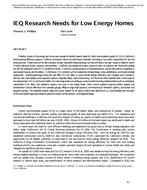Description
Potential impacts of low energy new homes were reviewed to identify research needs for indoor environmental quality (IEQ) in California’sbuilding energy efficiency programs. California and several nations are planning to implement low energy or low carbon requirements for new andexisting homes. These homes will be well-insulated, airtight, high-performance buildings, but they will have a narrower margin of safety for controlof indoor pollutant sources, moisture, and ventilation. California has reduced some major sources of indoor air pollution over the last few decadesbut still has substantial rates of IEQ problems in homes. It also has a growing fraction of vulnerable persons, persons with asthma, households inovercrowded housing, and the elderly. In the future, IEQ problems will be impacted by climate change, urban densification, and transit-orienteddevelopment. Building technology trends that will affect IEQ for better or worse include reduced infiltration and increased use of insulation,thermal mass, fault detection and diagnostics systems, integrated design, and commissioning. We found very little available data on the impact oflow energy homes on IEQ and human health, but a few large studies are underway. Several studies have documented problems such as overheating,maintenance of air filters and ventilation systems, and noise in low energy homes. Other current problems requiring further research anddemonstration include infiltration from attached garages, effective range hood operation, commissioning of ventilation systems, and builder andoccupant training. We identified research needs and current research for all types of factors that determine IEQ, and concluded that the majordrivers and research gaps were related to pollutant sources, human behavior, and integrated design.
Citation: IAQ Conference: IAQ 2013: Environmental Health in Low Energy Buildings
Product Details
- Published:
- 2013
- Number of Pages:
- 8
- File Size:
- 1 file , 430 KB
- Product Code(s):
- D-2013IAQConf-50




